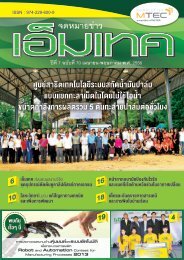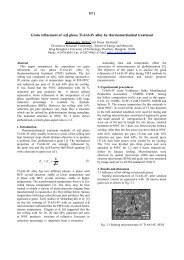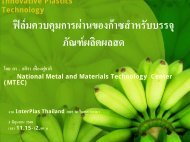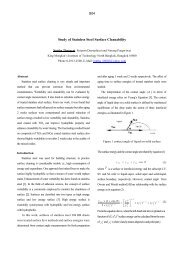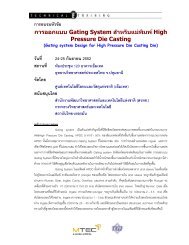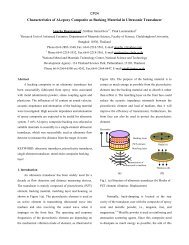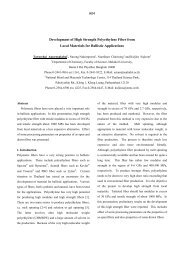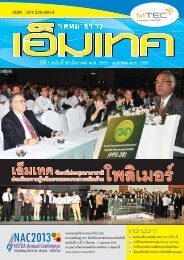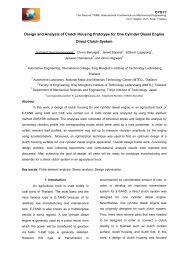EUROPEAN WHITE BOOK
EUROPEAN WHITE BOOK
EUROPEAN WHITE BOOK
You also want an ePaper? Increase the reach of your titles
YUMPU automatically turns print PDFs into web optimized ePapers that Google loves.
MAX-PLANCK-INSTITUT FÜR METALLFORSCHUNG STUTTGART30hosts for nuclear waste immobilization, port liners for dieselengines, and coating materials for C/C composites.(b) Processing and microstructural designCeramics are synthesized into glasses, polycrystals, andsingle crystals, and many forms dictated by their use, includingfine powders, fibres, thin films, thick films, coatings,monoliths, and composites. Polycrystalline componentsare conventionally produced by powder synthesisand forming processes followed by sintering at high temperature.The performances of ceramic materials are determinednot only by the structure and composition, butalso by defects (such as pores), second phases (which canbe deliberately added to facilitate processing), and interfaces.Thus, one of the primary limitations of current ceramicprocessing technologies is that they are an art as wella science. This situation is changing progressively. For instance,in order to meet the requirements of miniaturizationand integration, these techniques have to be supplementedby deposition techniques, such as physical vapourdeposition (PVD), pulsed-laser deposition (PLD), chemicalsolution deposition (CSD), and chemical vapour deposition(CVD). During these processes, the materials aresynthesized on a microscopic scale without powder processingas an intermediate step, usually at temperaturesmuch below the typical sintering temperature of bulkmaterials. Not only can ceramic materials of small dimensions(e.g., the size of semiconductor chips) then bedeposited, thus responding to the integration needs ofdifferent materials, but their ceramic compositions andstructures can also be designed much more flexibly. Theunderstanding and mastering of phenomena at the microscopicand, more importantly, at the nanoscopic scalesclearly need further basic research. A specific example canbe found in thin films of ferroelectrics, where dielectricproperties are dominated by interfacial effects rather thanby the bulk capacitance.A great challenge is the architecture of ceramic materialsin atomic dimensions, not only in thin films but also in thickfilms and bulk materials. The ceramic materials will openup novel classes of materials with properties still unknownwith respect to conventionally processed materials. Onepossibility for research is the thermally induced transformationof preceramic compounds by solid state thermolysis(SST). By tailoring the composition and molecular structureof precursors by means of advanced chemical syntheses,and by controlling thermolysis, the composition,structure, and microstructure of ceramic materials can bedesigned. The characteristics of precursor thermolysis, andthe relative ease with which various geometries can be processedat the preceramic stage (such geometries includefibres, thin films and coatings, infiltrates, bulk materials,etc.), using standard polymer processing techniques,makes them highly applicable for the production of fibrereinforcedcomposites, oxidation-resistant coatings, wearresistantmaterials, and many others.Another growing field of research with an attractive technicalpotential is the production of materials inspired bybiomineralization. Oxidic deposits from aqueous solutionson organically modified surfaces, for example, provide asynthesis route for ceramics at ambient conditions. Suchtemplate-induced and self-assembled materials using biomimetictechniques provide “soft,” low-cost routes, offeringreal opportunities to get new metastable materials thatpossess original microstructures as layered polymer-ceramiccomposites and cannot be obtained by conventionalhigh-temperature routes. Therefore, the investigation ofinteractions between organic and inorganic phases, as wellas nucleation and growth phenomena, is a promising areaof basic research.Nevertheless, conventional elaboration processes will continueto offer breakthroughs. A deeper understanding ofthe surface chemistry of powders will lead to a better controlof the interaction between particles during colloidalpowder processing, thus providing a means for controllingpowder consolidation and defect-free microstructure.New methods for net-shape forming based on the controlof interparticle forces in dense suspensions of powdershave been proposed recently. There is no doubt that possibilitiesoffered by surface chemistry are far from beingfully exploited, especially in the case of nonoxide ceramics.Among the challenges for future years is the developmentof processing paradigms for the production of finerpowders, which could lead to new applications resultingfrom different green-state architectures.Direct and indirect cost savings by process-cost reductionsand product improvements, respectively, are necessary inthe field of advanced properties of ceramics. Cost savingsare typically achieved by a better understanding of the fundamentalsof the underlying processes. Savings could alsobe obtained by new types of low-cost processes, componentdesign changes or simplifications by using proper joiningtechniques, or product-development time reductions(e.g., by rapid prototyping). In essence, processing scienceremains a net priority, but in the case of ceramics, it nowextends far beyond the simple processing of powders.(c) Miniaturization and integrationOne of the great challenges and opportunities in advancedprocessing lies in the miniaturization and integration ofdifferent classes of materials (e.g., ceramics, metallic alloys,polymers). Miniaturization requires a search for new



